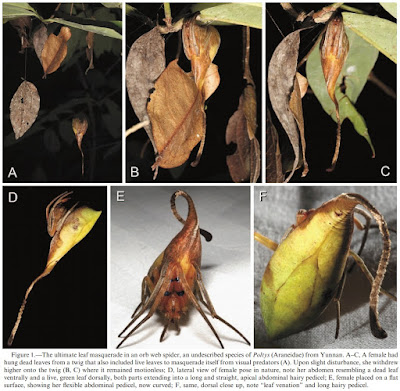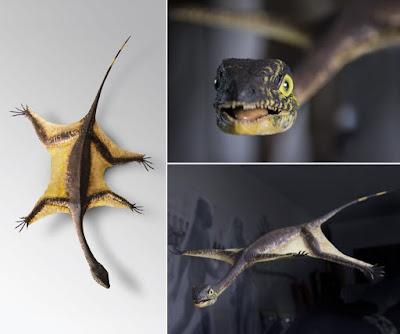[Most Recent Entries] [Calendar View]
Tuesday, November 29th, 2016
| Time | Event | ||
| 8:23a | [Arachnida • 2016] Leaf Masquerade in An Orb Web Spider Genus Poltys C.L. Koch, 1843, (Araneidae) Abstract Leaf masquerade—an animal resembling leaves that are inedible for predators or innocuous for prey—is well known in insects but less so in arachnids. We report a case of a striking morphological and behavioral adaptation that can be labeled as leaf masquerade in an undescribed spider species (Poltys C.L. Koch, 1843, Araneidae) from southwest China. The female abdomen has anatomical analogues of a leaf pedicel and venation, and its color is both green and brown, thus resembling both live and dry leaves. The spider camouflages itself with pulled dead leaves among live ones. This novel natural history in a spider adds an arachnid model to the growing literature on animal masquerade. Keywords: Passive defenses, anachoresis, crypsis, Poltys, Araneidae Matjaž Kuntner, Matjaž Gregorič, Ren-Chung Cheng and Daiqin Li. 2016. Leaf Masquerade in An Orb Web Spider. Journal of Arachnology. 44(3);397–400. This Never Before Seen Spider Looks Like a Leaf http://on.natgeo.com/2fVTnex via @NatGeo | ||
| 3:08p | [Botany • 2016] Hydnophytum puffii • A New Ant-plant (Rubiaceae: Psychotrieae) from Sabah, Malaysian Borneo Abstract Background – Hydnophytum puffii Y.W.Low, Sugau & K.M.Wong, a linear-leaved epiphytic ant-plant is described as new from Borneo using morphological characters based on specimens preserved in the Sandakan and Singapore Herbaria. This new species is so far known only from Sabah, Malaysia. Methods – This study is based on herbarium materials and field observations in Sabah. Conventional herbarium techniques were applied for taxonomy, while the IUCN conservation status was assessed using GeoCAT. Results – Hydnophytum puffii is closely related to H. angustifolium Merr. but differs in having glabrous young twigs, 4–5 pairs of leaf secondary veins on the lower leaf surface, a corolla tube that is densely covered with translucent hairs inside the throat around the anthers, and prolate mature fruits. This new taxon is the only species in Borneo to have linear leaves as the other two taxa, namely H. coriaceum Becc. and H. formicarum Jack have broad elliptic leaves. Key words – Borneo, conservation status, Hydnophytum, Malaysia, new species, Psychotrieae, Rubiaceae, Sabah. Yee Wen Low, John B. Sugau and Khoon Meng Wong. 2016. Hydnophytum puffii (Rubiaceae: Psychotrieae), A New Ant-plant from Sabah, Malaysian Borneo. Plant Ecology and Evolution. 149(1):123-130. DOI: 10.5091/plecevo.2016.1102 | ||
| 3:22p | [Paleontology • 2016] Ozimek volans • An Early Late Triassic Long-necked Reptile with A Bony Pectoral Shield and Gracile Appendages
Several partially articulated specimens and numerous isolated bones of Ozimek volans gen. et sp. nov., from the late Carnian lacustrine deposits exposed at Krasiejów in southern Poland, enable a reconstruction of most of the skeleton. The unique character of the animal is its enlarged plate-like coracoids presumably fused with sterna. Other aspects of the skeleton seem to be comparable to those of the only known specimen of Sharovipteryx mirabilis from the latest Middle Triassic of Kyrgyzstan, which supports interpretation of both forms as protorosaurians. One may expect that the pectoral girdle of S. mirabilis, probably covered by the rock matrix in its only specimen, was similar to that of O. volans gen. et sp. nov. The Krasiejów material shows sharp teeth, low crescent scapula, three sacrals in a generalized pelvis (two of the sacrals being in contact with the ilium) and curved robust metatarsal of the fifth digit in the pes, which are unknown in Sharovipteryx. Other traits are plesiomorphic and, except for the pelvic girdle and extreme elongation of appendages, do not allow to identify any close connection of the sharovipterygids within the Triassic protorosaurians. Key words: Archosauromorpha, Sharovipteryx, protorosaurs, gliding, evolution, Carnian, Poland. Systematic palaeontology Archosauromorpha von Huene, 1946 Family Sharovipterygidae Tatarinov, 1989 Genus Ozimek nov. Type species: Ozimek volans gen. et sp. nov.; see below Etymology: After the borough town Ozimek nearby the type locality. Diagnosis.—As for type and only species. Ozimek volans gen. et sp. nov. Etymology: From Latin volans, flying. Holotype: Incomplete skeleton ZPAL AbIII/2512 (Fig. 7). Type locality: Krasiejów near Ozimek, Upper Silesia, Poland. Type horizon: Lacustrine bed, probably late Carnian, early Late Triassic. Diagnosis.— Enlarged coracoids that meet along the mid-line forming a slightly convex ventral shield; low, crescentshaped scapula. Jerzy Dzik and Tomasz Sulej. 2016. An Early Late Triassic Long-necked Reptile with A Bony Pectoral Shield and Gracile Appendages. Acta Palaeontologica Polonica. 61(4); 805-823. DOI: 10.4202/app.00276.2016 |
| << Previous Day |
2016/11/29 [Calendar] |
Next Day >> |


















